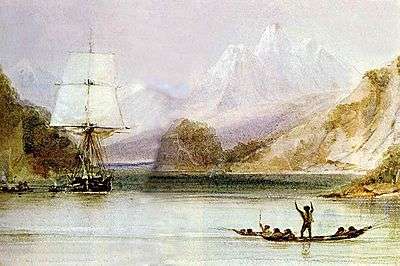Geological Observations on South America
| Author | Charles Darwin |
|---|---|
| Language | English |
| Genre | Geology |
Publication date | 1846 |
| Media type | Book |
Geological Observations on South America is a book written by the English naturalist Charles Darwin. The book was published in 1846, and is based on his travels during the second voyage of HMS Beagle, commanded by captain Robert FitzRoy. The HMS Beagle arrived in South America to map out the coastlines and islands of the region for the British Navy. On the journey, Darwin collected fossils and plants, and recorded the continent's geological features.[1]
It is the third book in a series of geology books written by Darwin,[2] which also includes The Structure and Distribution of Coral Reefs, published in 1842, and Geological Observations on the Volcanic Islands visited during the Voyage of the H.M.S. Beagle, published in 1844. It took Darwin four years to write and complete the entire series,[3] from 1842 to 1846. According to his diaries, Geological Observations of South America was written between July 1844 to April 1845.[4]
The text contains eight chapters along with appendices on Darwin's Mesozoic and Tertiary fossils.[5] It describes his travels through the regions of modern Chile, Brazil, and Argentina, including the Pampas, Patagonia, and the Andes.[5] With this book Darwin became the first to describe and name Navidad Formation,[6] the reference unit for the marine Neogene in Chile.[7] Darwin, in a letter to the geologist Charles Lyell, wrote that the book was "dreadfully dull, yet much condensed."[4] He put a great deal of effort into writing the book, but sardonically commented that "geologists never read each other's works, and that the only object in writing a book is a proof of earnestness, and that you do not form your opinions without undergoing labour of some kind."[4]
In the book, Darwin voiced sceptical support for the "crater of elevation" theory. The theory proposed that volcanoes were not the product of lavas, but are pushed up from within. Darwin later rejected the theory when sufficient evidence was demonstrated by the geologist Charles Lyell to disprove it.[8]

Francis Darwin, a botanist and the son of Charles Darwin, wrote that the book was significant for the "evidence which it brought forward to prove the slow interrupted elevation of the South American continent during a recent geological period."[2] Darwin's geological work is not considered as notable as his work is biology, but nevertheless was important in advancing "the general reception of Lyell's teaching."[4]
References
- ↑ Kohn, David (1996). On Evolution: The Development of Theory of Natural Selection. Hacket Publishing. p. xiii. ISBN 9780872202856.
- 1 2 Darwin, Charles (1901). The life and letters of Charles Darwin. D. Appleton. p. 20.
- ↑ Charles Darwin (14 May 2010). The Autobiography of Charles Darwin. Bibliolis Books. p. 78. ISBN 978-1-907727-04-7. Retrieved 5 August 2012.
- 1 2 3 4 Charles Darwin (1896). The life and letters of Charles Darwin. D. Appleton and company. pp. 295–303. Retrieved 5 August 2012.
- 1 2 van Wyhe, John (2002). "Introduction to South America". The Complete Work of Charles Darwin Online. Retrieved 29 July 2012.
- ↑ Gutiérrez, Néstor M.; Hinojosa, Luis F.; Le Roux, Jacobus P. (2013), "Evidence for an Early-Middle Miocene age of the Navidad Formation (central Chile): Paleontological, paleoclimatic and tectonic implications", Andean Geology, 40 (1): 66–78
- ↑ Encinas, Alfonso; Buatois, Luis A.; Finger, Kenneth L. (2008), "Paleoecological and paleoenvironmental implications of a high-density Chondrites association in slope deposits of the Neogene Santo Domingo Formation, Valdivia, south-central Chile", Ameghiniana, 45 (1): 225–231
- ↑ Herbert, Sandra (2005). Charles Darwin, Geologist. Cornell University Press. pp. 241–242. ISBN 9780801443480.